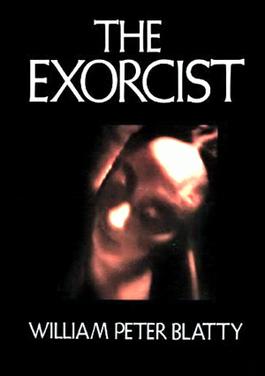I must opine that this book did not plunge my attention into anything serious; in fact, I struggled, at times, in the infancy of this dark narrative, just to get through the first few chapters. Normally, this problem, if it occurs at all, corrects itself rather quickly; Blatty’s work here did not do this. The dialogue is dry; the plot seems to me, at times, deflate on itself. I found myself in a brawl with each page. Then something cleverly sinister happened; I became awakened and intrigued. The darkness is bright as the book ripens. So, how did Blatty do this, exactly? It is actually a brilliant process.
The protagonist is a young call whose name is Regan. By all accounts, she is sweet and devoted to her mother; she leaves surprises at the breakfast table each morning; she is bubbly and full of life. All seems well in this household. This is where Blatty, who is brilliant in his gradual deliverance, begins to show the reader that all is not as it seems. Strange occurrences begin to present themselves; furniture moves by itself; strange sounds are coming from various rooms and hallways throughout the house; there is a strange screeching noise that irritates Regan’s mother, Chris, each night. Then, it commences on transforming Regan’s behavior from a subtle little girl, to one who lashes out, curses, and hurls insults at the doctors who examine, by the request of her mother, to determine the cause of such a bizarre behavior pattern Regan has accrued; they cannot present a candid explanation to Chris. This result frustrates her even more and Regan’s behavior continues to grow more sinister and dark. The plot acts out on a slow pulse, just barely alive, into a throbbing and wickedly upbeat diabolical energy and activity. In one grizzly scene in the book, most of Regan’s personal objects, upon her mother entering her room, are flying violently and romping above her and her daughters head. The emanation of these actions compels Chris to seek further treatment from a collaboration of clinical doctors and psychologists; like Regan’s first initial examination, there is no one who is able to offer a satisfactory explanation of such fiendish results and circumstances. Desperate to find an answer, Chris consults with professionals outside the scope of the Scientific community: she seeks out a priest.
Enter Jesuit priest Father Damien Karras: in my view, he is the most intriguing and ironic of all the characters in this book. He is not only a Jesuit; he is a trained Psychologist who is struggling with his Christian faith. In an attempt to grieve over the unexpected death of his mother, his faith sinks to a serious level of doubt and hopelessness; it is just then that Chris consults his expertise in order to try to figure out what is causing her daughter to transform into something, quite revealing, unhuman; she has arrived at the terrifying conclusion that her daughter in demonically possessed and requires the aide of a Roman Catholic priest; there is where the novel transforms itself from a tapestry of uncertainty and senselessness, to where the possibility exists that something dark and menacing lurks within Regan. However, at first, even Father Karras has his doubts, as he unmercifully demonstrates within his dialogue with Regan’s mother, until he makes a mysterious and creepy visit to her bedroom where she is tied down onto all four bedposts to prevent her from self-mutilation; the scene is rather quite terrifying and Father Karras is uncertain on what judgement to pronounce. As he continues with his examination, much to his surprise, Regan reveals information to him that only he could possibly know; this convinces him to make inquiries to the church in order to obtain permission to perform an exorcism. While Father Karras has never performed one of these, the Diocese insists that a more experienced priest perform the ritual where Karras reluctantly agrees.
Enter Father Lankester Merrin: Lankester is well-renowned in the book as an expert on performing exorcisms. In a selective and particular mention, he is nearly killed in his involvement in one. Eventually, Father Merrin is summoned to the residence of Regan’s house along with Father Karras to assist. What at first seems to be a mundane/exorcist ritual turns fatal for one of them. With a few brief instructions from Merrin to Karras, they commence. At first, Regan is sluggish to the responses; she unwillingly lashes out at them, specifically at Karris in order to weaken his intentions. It can be argued or suggested that a demon is doing this that is inside of Regan, as both Jesuits believe, and the only real hope of saving her body and soul is Jesus Christ himself. As the exorcism grows more deadly, the bed levitates, Regan is able to turn her head completely around, regurgitates unimaginable mucus on both priests, lewd acts of sexually charged obsessions with her body and grows immensely violent and quite powerful in both strength and manipulation suggesting that these feats are the presupposition of adult habits and rituals administered by Paranormal mischievousness. The book produces intense scenes of tests of conviction, believing in humanity and the power of the Roman Catholic faith. In an exclusive episode of fear, Father Karras presents a paroxysm of screaming when Regan/The Demon begins to imitate, exactly, the voice of his late mother. This causes Father Karras to momentarily lose his grip on his own performance. At the request of Father Merrin, he steps out of the room with Merrin taking over the exorcism alone. After a little moment passes, Father Karris enters the room and discovers Merrin is dead. This enrages him and begins to violently attack the body of Regan demanding that the evil entity take possession of himself; his wish is granted. Karris, almost immediately, begins to show signs that something has taken over his body. While violently trashing around on the floor, tragically, he is somehow forced to jump out of Regan’s upstairs bedroom window to his death down below. While bloody and barely conscious, a fellow priest is quickly summoned and administers his last rites, fully reconfirming his newly healed faith in the Church and Christ. Regan returns back to her completely normal self without hardly any recollection to the exorcism.
William Peter Blatty offers many lessons in this book if we are just able to at least consider them; while the novel is dark and full of uncertainty, there are bridges of hope the reader may cross if willing. While the ending is tragic, it is triumphant. It is important to present in dialogues of discussion that evil, while tumid and quite real, providence and faith are the destruction of its spirit. While the author spends a considerable time crafting dullness and uneventfulness, when on pays careful attention, there is method to the insanity. Each incident sets up the next one. It is a careful and exhaustive display of wordplay, semantics and unorthodox methods of plot changing tactics not foreseen in any horror novel of the time; this example alone is impressive enough. That is not to say this book is the first of its kind. Blatty got the idea of his work from reading another work of possession entitled, “Possession: The True Story Of An Exorcism” by Thomas B. Allen written much earlier about a boy who exhibits remarkably similar behaviors to that of Regan. (You can read my review on this work here). Subsequently, this book inspires faith, courage, and confidence, irrespective on your current situation or outlook on life. This is a lesson that we continue to need reminding of.
© 2024, Mark Grago. All rights reserved.





